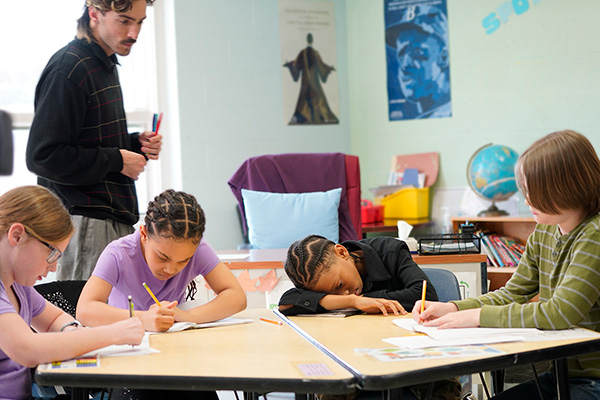Why do students engage in certain behaviors?
Page 1: Behavioral Form and Function
 Challenging behaviors—those that interrupt instruction and have a negative impact on the learning environment—can be frustrating for everyone involved. They can interfere with teachers’ ability to teach, students’ ability to learn, and interactions and relationships among peers and adults. For this reason, they are also referred to as interfering behaviors.
Challenging behaviors—those that interrupt instruction and have a negative impact on the learning environment—can be frustrating for everyone involved. They can interfere with teachers’ ability to teach, students’ ability to learn, and interactions and relationships among peers and adults. For this reason, they are also referred to as interfering behaviors.
Often, educators can effectively address interfering behaviors by using comprehensive classroom behavior management and low-intensity strategies (e.g., behavior-specific praise, precorrection, choice making). However, when such strategies are not enough, educators might need to conduct a functional behavioral assessment (FBA). In simplest terms, an FBA is a systematic process through which educators ask not only “What does the student do?” but “Why does the student do that?”
comprehensive classroom behavior management
glossary
low-intensity strategies
glossary
Typically, educators can easily describe what a particular interfering behavior looks like and its general effect on the classroom environment. For example, do any of these scenarios sound familiar?
- A student repeatedly calls out at inappropriate times, interrupting the lesson and preventing other students from responding.
- A student puts their head down and withdraws during instruction and, as a result, falls behind academically.
- A student throws books and other objects, creating an unsafe situation for all students in the classroom.
You might be surprised to learn that these students’ behaviors are not random. Whether the student is actively acting out or passively withdrawing, they are engaging in these behaviors for a reason. Although it is helpful to understand the form that an interfering behavior takes (i.e., the “what”), it is even more important to determine the purpose, or function, of that behavior (i.e., the “why”).
The events that occur in the environment before and after an interfering behavior can provide clues to its function. These events are referred to as antecedents and consequences, respectively. In particular, the function of a behavior is closely connected to the type of reinforcement that typically follows it. In effect, reinforcement is how a behavior pays off. When a student engages in a behavior that consistently results in reinforcement—gaining access to something desirable or escaping something undesirable—they become more likely to engage in that behavior in the future. Therefore, understanding the type of reinforcement that influences a behavior is essential to identifying its function. For the purposes of an FBA, the functions of behavior are simplified into the four categories summarized in the table below.
antecedent
glossary
consequence
glossary
reinforcement
glossary
| Function | Description |
| Attention | The student seeks social interactions, recognition, or assistance from others. Even negative attention from peers or educators (e.g., teacher reprimands, peer reactions) can reinforce a student’s behavior. |
| Items or Activities | The student seeks access to tangible items (e.g., sticker, toy) or intangible activities (e.g., being first in line, using technology, playing a game). |
| Escape | The student seeks to change, stop, or take a break from a difficult or unpleasant experience. In the classroom, this might include escaping from challenging academic work, sensory environments, or social interactions. |
| Automatic |
The student engages in behaviors that produce internal sensations such as sensory stimulation, relief from discomfort, or reduction of anxiety. These behaviors are referred to as self-stimulatory and could include self-injury, thumb-sucking, rocking, or hand flapping. Note: Automatic functions are very rare. Because there are complex ethical considerations for attempting to change self-stimulatory behavior, educators should always consult with other relevant professionals (e.g., behavior analysts, occupational therapists) if this function is suspected. x
behavior analyst glossary x
occupational therapist (OT) glossary |
Understanding the function of behavior involves recognizing that all humans engage in various behaviors to meet fundamental needs. Each of the four functions in the table above represents such needs.
- Attention addresses the need for relationships, connection, and belonging.
- Items or activities addresses the need for material items related to sustenance, shelter, learning, and leisure, among others.
- Escape addresses the need to relieve and manage distress.
- Automatic addresses the need to experience certain physiological sensations.
Viewing interfering behaviors through the lens of their functions helps educators better understand the underlying needs that are driving a student’s actions. By conducting an FBA, educators seek to identify the “why” behind a behavior and use this information to address its root cause and promote the student’s long-term success.
For Your Information
- All student behavior—whether it supports or interferes with learning—ultimately serves a function. For example, two students need a break during a long and challenging writing task. One student raises their hand and receives the teacher’s permission to take a short break while the other crumples up their paper and throws it in the trash. Both behaviors effectively served the function of escape even though they took very different forms.
- Interfering behaviors can emerge from skill deficits. For example, if a behavior is reinforced by escape from an instructional task, the student might lack the academic skills needed for the task. Similarly, if a student exhibits behavior to access items or activities, the student might lack the necessary communication skills to express their wants and needs.
Returning to the Challenge
DJ’s and Presley’s teachers can easily describe their interfering behaviors, which are detailed below. In both cases, it will be essential to determine the function of the interfering behavior—in other words, how does it pay off for the student? What is the underlying need that each student is expressing?
 DJ is well-liked by his peers and is always ready with a joke. He enjoys being physically active by playing basketball and soccer. His grades have recently started declining, mostly as a result of missing assignments and lack of participation. His teacher reports that he is always off task and needs constant redirection. DJ’s behavior takes the form of verbalizations (e.g., jokes, comments, conversations).
DJ is well-liked by his peers and is always ready with a joke. He enjoys being physically active by playing basketball and soccer. His grades have recently started declining, mostly as a result of missing assignments and lack of participation. His teacher reports that he is always off task and needs constant redirection. DJ’s behavior takes the form of verbalizations (e.g., jokes, comments, conversations).
 Presley enjoys drawing and coloring and responds well to activities involving visuals and hands-on activities. She has limited language skills, typically communicates using single words or short phrases, and has been identified as having a developmental delay. Presley’s teacher reports that her behaviors seem to come out of nowhere and take the form of physical actions against others (e.g., hitting, kicking, pushing).
Presley enjoys drawing and coloring and responds well to activities involving visuals and hands-on activities. She has limited language skills, typically communicates using single words or short phrases, and has been identified as having a developmental delay. Presley’s teacher reports that her behaviors seem to come out of nowhere and take the form of physical actions against others (e.g., hitting, kicking, pushing).

For additional information about content discussed on this page, view the following IRIS resources. Please note that these resources are not required readings to complete this module. Links to these resources can be found in the Additional Resources tab on the References, Additional Resources, and Credits page.
Classroom Behavior Management (Part 1): Key Concepts and Foundational Practices This module overviews the effects of disruptive behaviors as well as important key concepts and foundational practices related to effective classroom behavior management, including cultural influences on behavior, the creation of positive climates and structured classrooms, and much more (est. completion time: 2 hours).
Addressing Challenging Behaviors (Part 2, Elementary): Behavioral Strategies The second in a two-part series, this module describes strategies that teachers can implement to prevent or address challenging behaviors (est. completion time: 2 hours).
Behavioral Principles: The Basics of Understanding Student Behavior This module examines the ABC (antecedent-behavior-consequence) model, which illustrates how environmental factors can influence behaviors before and after they occur. This module also explores other foundational concepts involved in understanding, addressing, and changing behavior (est. completion time: 1 hour). |